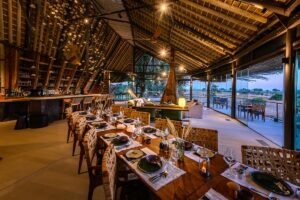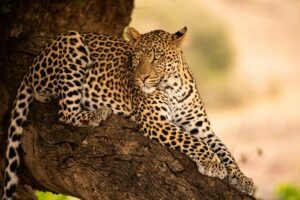There’s nothing quite like the Great Migration.
Imagine the ground trembling as millions of wildebeest, zebras and gazelles move across the Serengeti-Mara ecosystem in search of fresh grazing, dodging predators and facing life-or-death challenges.
This isn’t just a safari; it’s one of the most awe-inspiring natural events on the planet.
But while the spectacle is unforgettable, planning the perfect Great Migration safari can be daunting.
When should you go? Where should you stay? What’s the best way to avoid common pitfalls?
That’s where I come in.
Having planned countless safaris for my clients, I’m here to help you navigate the details so you can enjoy this incredible journey without the stress.
The Migration Cycle: An Overview
The Great Migration is a year-round phenomenon driven by the need for fresh grazing and water.
It’s a circular journey that spans nearly 2,000 miles, with over 1.5 million wildebeest, 200,000 zebras and other species constantly on the move.
While it’s easy to picture the iconic river crossings, there’s so much more to it.
Each phase of the migration tells its own story, offering unique opportunities to witness nature at its rawest.
Where to See the Great Migration
Tanzania’s Serengeti National Park
The Serengeti is where most of the migration takes place, and it’s as wild and vast as you’d imagine.
The park’s endless plains are a stage for some of the most thrilling wildlife scenes you’ll ever see.
Best Time to Visit:
- January to March: This is calving season in the southern Serengeti. Imagine thousands of baby wildebeest finding their legs, while lions, cheetahs and hyenas lie in wait. It’s a time of new life, but also danger, with predators constantly on the prowl.
- July to September: If you’re dreaming of heart-pounding drama, this is the time for the famous river crossings at the Grumeti and Mara Rivers in the northern Serengeti. Picture herds packed tightly together, plunging into crocodile-infested waters, each step a gamble.
Best Places to Stay:
- Ndutu Plains (Calving Season): Mobile camps like Lake Ndutu Luxury Tented Lodge put you right in the middle of the action, ensuring you don’t miss a moment.
- Northern Serengeti (River Crossings): Luxury lodges like Serengeti Bushtops or mobile camps such as &Beyond Serengeti Under Canvas offer front-row seats to the migration, moving with the herds to guarantee prime viewing.
Kenya’s Maasai Mara National Reserve
By July, the herds cross into the Maasai Mara, drawn by its lush, green pastures.
The Mara may be smaller than the Serengeti, but it packs a punch when it comes to wildlife, especially during the migration months.
Best Time to Visit:
- July to October: This is peak migration season in the Mara. The sight of thousands of animals grazing across the Mara’s grasslands, combined with more dramatic river crossings, creates the ultimate safari experience.
Best Places to Stay:
- Mara Triangle: For panoramic views of the Mara River and prime positions during the crossings, consider staying at Angama Mara or Governors’ Camp.
- Mara North Conservancy: For a quieter, more intimate experience, camps like Elephant Pepper Camp and Ngare Serian offer exclusivity and fewer crowds.
Timing Your Visit: Month-by-Month Breakdown
- December – March (Southern Serengeti): Calving season, with predator-prey action at its peak.
- April – June (Western Serengeti): Herds head toward the Grumeti River, but beware of heavy rains that can make some roads impassable.
- July – October (Northern Serengeti & Maasai Mara): Peak season, with thrilling river crossings.
- November (Central Serengeti): The herds begin their journey south again, completing the cycle.
6 Tips for the Best Migration Experience
1.Book Early
The Great Migration is a global spectacle, drawing wildlife enthusiasts from around the world. To secure the best camps or lodges, especially during peak migration periods like the river crossings, it’s essential to book well in advance. Think months, not weeks!
2. Choose the Right Camps
The magic of the migration is all about being in the right place at the right time.
Mobile camps that move with the herds are a fantastic choice as they ensure you’re always close to the action.
For a bit more comfort, there are also luxury lodges strategically located along the migration routes, providing excellent access while you enjoy a bit of pampering.

3. Consider Private Reserves and Conservancies
During peak migration times, the popular spots can get crowded, especially in the Maasai Mara.
For a more intimate and serene experience, consider staying in private conservancies. These areas border the main parks but have strict visitor limits, so you won’t find a sea of safari vehicles around every corner.
Plus, the wildlife encounters are often just as, if not more, spectacular.
4. Plan for River Crossings—but Be Flexible
There’s nothing like the drama of a river crossing: the tension as the herds gather on the banks, the suspense, and then the sudden burst of movement as they plunge into the water. But they’re unpredictable.
The herds can linger on the banks for days before finally taking the plunge, and patience is key.
If witnessing a crossing is a must-see for you, plan to spend a few days in places like the Mara Triangle or Northern Serengeti to increase your chances.
5. Prepare for Long Drives
Tracking the herds often means covering a lot of ground. While these drives are filled with game-viewing opportunities, they can be long, especially for first-time safari-goers.
Keep in mind that the journey is part of the adventure, and every bend could bring an unforgettable sighting.
6. Pack Wisely
- Binoculars: You might be watching a herd on the move or looking out for a leopard hidden in the tall grass, so a good pair of binoculars is essential.
- Layers: Mornings and evenings can be chilly, even in the hottest parts of Africa, while midday temperatures can soar. Dressing in layers will keep you comfortable throughout the day.
- Camera with Zoom Lens: Your smartphone can capture some great shots, but if you’re keen on photography, a camera with a decent zoom lens will let you capture those close-ups of wildlife action.
4 Common Pitfalls to Avoid
1.Underestimating the Importance of Guides
A great guide can turn a safari from good to extraordinary.
The best guides don’t just find animals; they bring the bush to life, sharing insights, stories and details you’d never notice on your own.
I make sure to work with companies that hire only the most knowledgeable and passionate guides, so your safari experience is in expert hands.

2. Overcrowded Safari Vehicles
It’s a sad truth that some of the most famous parks can get quite busy during peak migration times. Imagine being surrounded by dozens of vehicles all jostling for the best view.
I recommend staying in private conservancies or smaller, more exclusive camps to avoid this. You’ll get the same great views — just without the crowds.
3. Ignoring Visa and Vaccination Requirements
For UK travellers, visas are required for both Kenya and Tanzania.
The good news is that they’re relatively easy to obtain online or upon arrival, and I can help you navigate the process.
Don’t forget vaccinations either, including those for yellow fever.
I’ll ensure you have all the travel documents and health precautions sorted before you go, so there are no surprises.
4. Focusing Too Much on Migration
The Great Migration is a breathtaking sight, but there’s so much more to the Serengeti and Maasai Mara.
From spotting the Big Five (lion, leopard, rhino, elephant, and buffalo) to witnessing cheetahs sprint across the plains, there’s more to the safari experience than just the migration.
Balancing your time between migration events and other wildlife encounters will make your safari richer and more rewarding.
Conclusion
Experiencing the Great Migration is a journey like no other, filled with awe, drama and the raw beauty of nature.
From planning the right timing to choosing the perfect camp, it’s about getting the details right. With my years of experience organising safaris, I can help you do just that.
Planning Your Great Migration Safari?
Planning a Great Migration safari is a once-in-a-lifetime opportunity, and you don’t want to get it wrong.
Imagine booking the wrong lodge and missing the most spectacular river crossings. Or ending up in a crowded area where the magic of the migration feels more like a traffic jam.
It’s a trip you’ve dreamt about for years, and the last thing you want is to come away feeling like you didn’t see the best of this awe-inspiring natural spectacle has to offer.
I’ve helped countless clients avoid these pitfalls and plan their dream Great Migration safaris, and I’d love to do the same for you.
My goal is to take the stress out of planning, so you can focus on enjoying every breathtaking moment.
Let me handle all the logistics—flights, transfers, lodges, and even those little extras that make a trip special, like private bush dinners or hot air balloon rides over the savannah at dawn.
I can guide you to the best, less-crowded areas of the Mara or Serengeti, where you’ll witness the migration away from the hustle and bustle, and ensure you get expert recommendations on the best lodges, whether you’re after a luxury retreat or a classic tented camp.
So, don’t leave this to chance. Give me a call on 01372 677999 or send an email to
janey@berrytravel.co.uk.
We can have a quick chat to understand exactly what you’re looking for, and then I’ll take care of everything.
There’s no obligation to book, but you’ll walk away with invaluable advice to make sure your Great Migration safari is everything you’ve dreamed of—and more.
Haven’t read my guide, How to Find Your Perfect Safari?
In just 10 minutes, you’ll learn about the Big 5 destinations, the best times to visit, and insider tips—including how to pair your safari with the perfect beach escape.
It’s free — download now for your perfect safari!




